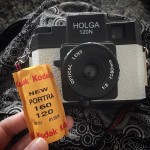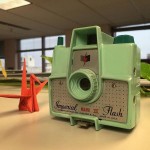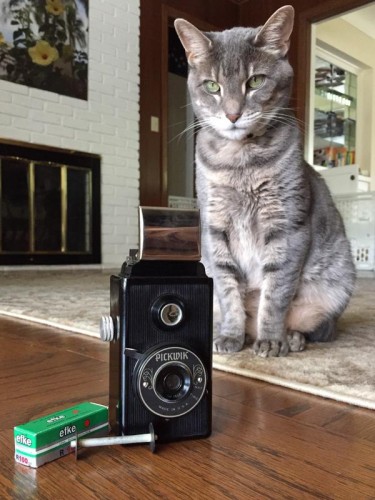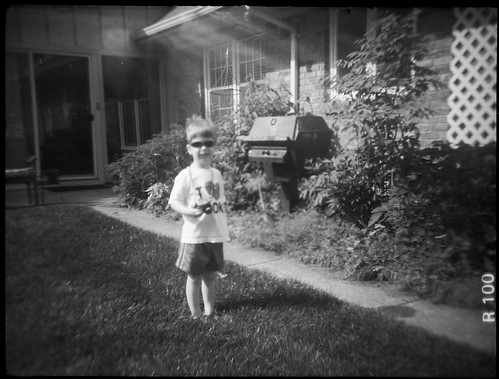It’s becoming more evident to me that, if I choose to ramp up my hobby of collecting film cameras, and if I want said cameras to be in working condition, I’ll need to become proficient at (or at least less afraid of) camera repair.
In the queue for repairs (mostly minor), I now have two Argus Argoflex 75 pseudo-TLRs, one Argoflex TLR, a Ricoh 35 FM rangefinder, a couple of 110 SLRs, a Yashica Electro 35 with a broken battery test button, and something else I’m forgetting.
 I tried to start simple, by removing the lens on my Argus C3. Unfortunately, I was stymied by the very first step of unscrewing the idler gear cap, since the cap probably hadn’t been loosened in the past 50 years. Even a couple squirts of WD-40 didn’t help; after a half hour of futzing with it, I developed friction blisters on my finger and thumb and called it a night. I’d like to someday get the wide-angle lens for my C3, but until I can free up that idler gear cap, it’s a no-go.
I tried to start simple, by removing the lens on my Argus C3. Unfortunately, I was stymied by the very first step of unscrewing the idler gear cap, since the cap probably hadn’t been loosened in the past 50 years. Even a couple squirts of WD-40 didn’t help; after a half hour of futzing with it, I developed friction blisters on my finger and thumb and called it a night. I’d like to someday get the wide-angle lens for my C3, but until I can free up that idler gear cap, it’s a no-go.
I feel like I have the best possibility of fixing one of the Argoflex 75’s, as I have one beautiful-looking camera with a stuck shutter and one camera with a dirty lens and a broken film door but a working shutter. Hopefully I can get in there with some tiny screwdrivers and do a compare-and-contrast and make the pretty one work. Then maybe I can disassemble the dirty one and clean it, and there will be no stress about breaking it, since I will already have an identical camera that works.
Now that I’ve more intentionally purchased several cameras — that is, seeking them out on eBay rather than just happening across them at the thrift store or antique mall — it’s also becoming clear which way my camera collection is trending. I already knew that I only wanted functional cameras, but now I’m discovering that I also prefer cameras that suit my photography style. I tend to shoot street photography, cityscapes, and indoor candids, so I prefer lighter and more compact cameras with quick operation and not much futzing with settings.
That said, I have grown to appreciate my Argus C3 after running a couple rolls through it, and that’s about as manual as they come. If I want to take a film camera somewhere, though, it will likely be my Olympus XA. It’s small and light and as manual or automatic as the conditions warrant. But I’m curious about other rangefinders, too, so I’ve been picking some of those up on eBay — a Yashica Electro 35, Konica Auto S2, and Rollei 35, all of which I have yet to test.
 I also like the quirkiness and unpredictability of box cameras and toy cameras, especially those with a zone focus. My modified Holga is probably my favorite toy camera right now (as long as I remember to seal the light leaks with gaffer’s tape), although I also enjoy taking my pseudo-TLRs and box cameras (mostly Brownies) out for photo walks downtown.
I also like the quirkiness and unpredictability of box cameras and toy cameras, especially those with a zone focus. My modified Holga is probably my favorite toy camera right now (as long as I remember to seal the light leaks with gaffer’s tape), although I also enjoy taking my pseudo-TLRs and box cameras (mostly Brownies) out for photo walks downtown.
I had originally thought that I’d like to expand into the realm of TLRs, but I’m rethinking that now. I think that my concentration will be mainly compact rangefinders and Kodak Brownies (especially those that don’t require modifications to take modern film). Right now, they don’t need to be minty; they just need to work.
And that’s where the repair aspect comes in. I’m not especially handy, but I’m persistent, and focused, and I can learn.
 When I first bought this camera from the antique mall some eight years ago, I didn’t own any other 620 cameras — and even if I’d had an extra couple of 620 spools handy, it hadn’t even occurred to me to try respooling 120 film onto a 620 spool. I managed to run two rolls of 35mm through the camera to try some sprocket photography, but couldn’t quite get the film plane flat. It wasn’t until recently that I realized I now have enough extra 620 spools to run a real test roll through this cute little camera.
When I first bought this camera from the antique mall some eight years ago, I didn’t own any other 620 cameras — and even if I’d had an extra couple of 620 spools handy, it hadn’t even occurred to me to try respooling 120 film onto a 620 spool. I managed to run two rolls of 35mm through the camera to try some sprocket photography, but couldn’t quite get the film plane flat. It wasn’t until recently that I realized I now have enough extra 620 spools to run a real test roll through this cute little camera.


 I picked up the Pickwik Reflex at a garage sale for $4. As I recall, the woman assumed a camera that old (circa 1940) would only be good for decoration; she was surprised when I told her it looked like it would actually work.
I picked up the Pickwik Reflex at a garage sale for $4. As I recall, the woman assumed a camera that old (circa 1940) would only be good for decoration; she was surprised when I told her it looked like it would actually work.
 I picked up the Brownie Bullseye at a garage sale at the Old West End Festival a couple of years back for $3 or $4, boxed, with the flash attachment. After letting it sit in its box on top of my camera display shelf for a year or two, I finally got around to running a test roll through it this past May.
I picked up the Brownie Bullseye at a garage sale at the Old West End Festival a couple of years back for $3 or $4, boxed, with the flash attachment. After letting it sit in its box on top of my camera display shelf for a year or two, I finally got around to running a test roll through it this past May.
 I tried to start simple, by removing the lens on my Argus C3. Unfortunately, I was stymied by the very first step of unscrewing the idler gear cap, since the cap probably hadn’t been loosened in the past 50 years. Even a couple squirts of WD-40 didn’t help; after a half hour of futzing with it, I developed friction blisters on my finger and thumb and called it a night. I’d like to someday get the wide-angle lens for my C3, but until I can free up that idler gear cap, it’s a no-go.
I tried to start simple, by removing the lens on my Argus C3. Unfortunately, I was stymied by the very first step of unscrewing the idler gear cap, since the cap probably hadn’t been loosened in the past 50 years. Even a couple squirts of WD-40 didn’t help; after a half hour of futzing with it, I developed friction blisters on my finger and thumb and called it a night. I’d like to someday get the wide-angle lens for my C3, but until I can free up that idler gear cap, it’s a no-go. I also like the quirkiness and unpredictability of box cameras and toy cameras, especially those with a zone focus. My
I also like the quirkiness and unpredictability of box cameras and toy cameras, especially those with a zone focus. My